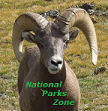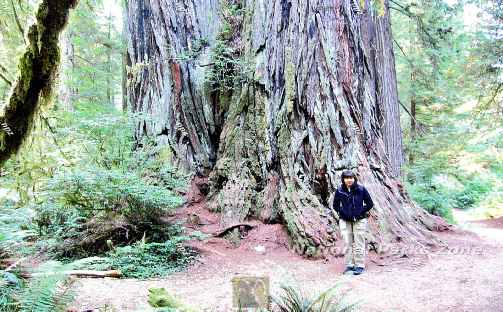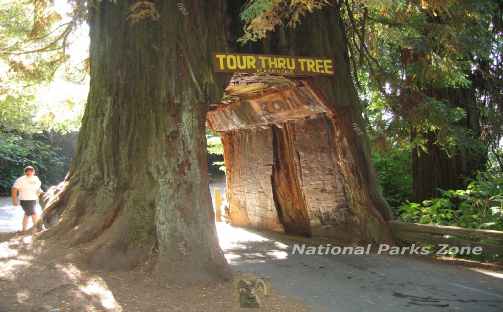Copyright © 2014-
All Rights Reserved

Updated 02/11/23 7:04 PM
Redwoods National and State Parks
Redwoods National and State Parks is a series of parks along 65 miles of California coastline created to preserve forests of thousand year old coast redwoods, the tallest trees in the world.
California
2011
Redwoods was an afterthought on a trip to see the national parks in the Pacific Northwest. I have to say I loved the park.
On a trip to see five national parks in the Pacific Northwest I was least interested in Redwoods. I had a certain amount of time and it didn’t fit in my itinerary. On the way from Lassen Volcanic National Park to San Francisco for a flight home I pulled into a gas station and called my boss and asked if I could take a few more days so I could visit Redwoods National Park.
I didn’t expect much of Redwoods but since I was not too far away I thought I might as well see it now instead of making a separate trip out of San Francisco on some future trip. Redwoods turned out to be a great park and much more than I expected.
Redwoods National and State Parks is the result of a cooperative effort between the National Park Service and the State of California to protect the coast redwoods which are the tallest and some of the most massive trees on Earth. The tallest tree in the park is Hyperion at 379.1 feet (115.5 m). The ‘tallest tree’ designation has changed over the years as other taller trees are discovered and also trees fall down, get hit by lightening or just seem to lose their tops. Coast redwoods can live to 2000 years with the average of 500-
Along with Redwoods National Park are California's Del Norte Coast, Jedediah Smith, and Prairie Creek Redwoods State Parks. To the visitors it is functionally one continuous park running for 65 miles along California’s northern coast.
About 60 miles south of Redwoods, along Highway 101, is Humboldt Redwoods State Park. If this were a bit further north I’m sure it would’ve been included in the Redwoods National and State Parks. Geography did not favor that. In any case I included it here because I highly recommend seeing it as an adjunct to a Redwoods National Park visit. Over 100 of the 137 known trees over 350 feet (110 m) tall—all coast redwoods—can be found in Humboldt Redwoods State Park. It is home to the 4th-
The ‘drive through tree’ pictured at the top is a practice that would be frowned upon today. It definitely is not good for the tree as it just hastens the day when that majestic giant falls over. There are several of these drive throughs. This one is on private land that charged a $5 entry fee (whether you drive through or not -
Wildlife
In Redwoods, over 40 species of mammals have been documented, including the black bear, coyote, cougar, bobcat, beaver, river otter, black-
Lodging
There isn’t a (national parks) lodge in the park per se and limited lodging options within the environs of the park. A web search may turn up some cabins. On my trip I found a motel in Arcata a few miles from the south end of the park. There’s lodging in Crescent City, at the north end of the park, and is another viable option.
Hiking
What I loved most about these parks, with their massive trees and giant ferns, was the feeling of being in Jurassic Park. And high on my list of such places is Fern Canyon in Prairie Creek Redwoods State Park. Fern Canyon’s prehistoric ambience was used in the Lost World: Jurassic Park movie and in the BBC series Walking With Dinosaurs (episode 2, at 10m 25s). Fern Canyon is reached by driving about 7 miles down unpaved Davison Road. The road surface is hard and it’s an easy, scenic drive that any 2-
As of October 27, 2018 the Loop trail in Fern Canyon was closed due to log jams but you could still walk ¼ mile into it. Apparently the narrowness of the canyon gives rise to significant flooding and the result is evident in the pictures in the photo gallery accompanying this page.
As with visiting any National Park you should always check with the NPS website for current conditions and alerts.
Lady Bird Johnson Grove Trail
Another easy hike in the southern part of Redwoods National Park is the Lady Bird Johnson Grove Trail -
Tall Trees Trail
A bit further south, still in Redwoods National Park, is the Tall Trees Trail which leads to the Tall Trees Grove. It once held the tallest tree in the park but at some point it lost a good deal of its top and no longer holds the record. Getting to the grove requires driving down a narrow, winding, unpaved road and requires a permit available at the visitor center. The hike is a 4-
Newton B. Drury Scenic Parkway
There’s a 10 mile spur road, the Newton B. Drury Scenic Parkway, which splits off from Highway 101 and back to it again. It’s a one-
Jedediah Smith Redwoods State Park
In the northernmost part of the park, in Jedediah Smith Redwoods State Park, is Howland Hills road which leads to the Stout Memorial Grove. This one-
Redwoods National and State Parks Photo Gallery
Other Resources
Redwoods National and State Parks on the National Parks Service website -
Redwoods National and State Parks -


Other National Parks Within a Day’s Drive
Crater Lake National Park the deep blue waters of this natural wonder is about 235 miles to the north and about a 4.5 hour drive.
Lasen Volcanic National Park with its volcanoes and thermal features is 245 miles to the southeast and about a 4.5 hour drive.
Pinnacles National Park where ancient volcanic spires can be found is 500 miles to north and about a 8 hour drive.
Mount St. Helens National Volcanic Monument where the famous 1980 eruption took place is 430 miles and about a 7 hour drive to the north.
*N*P*Z*
National Parks Zone